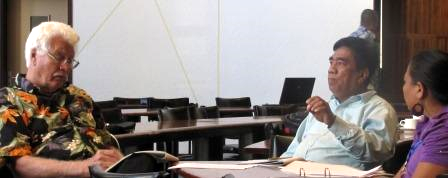
The island nation representatives to a Deep Sea Minerals meeting (organised by the Geoscience Division of the Secretariat of the Pacific Community) in April 2015; and the scientific and technical advisers attending the same meeting, most of whom were members of STAR, had agreed informally to adopt the GeoHab model as a way of reviving STAR so it doesn’t just die*. The GeoHab is to the Circum-Pacific Council what STAR was to the SOPAC (Pacific Islands Applied Geoscience Commission).
The GeoHab, like the STAR, convened annual meetings in conjunction with its ‘host’ organisation. The last STAR conference was held in 2013, in conjunction with a GSD heads of geosciences meeting. Now the talk is about having a more independent STAR. I am thinking that if STAR follows the GeoHab model then it is not seeking independence, but a new host organisation, since SOPAC, its old host, is in mothballs.
Upon request to Gary Greene (a senior member of STAR and also a member of the Board of Directors of the CPC) to provide some facts on the GeoHab model that STAR is aspiring towards he provided the coloured text below.
The salient features of the GeoHab model :
GeoHab has no formal By-Laws or Article of Incorporation, nor does it have officers or a Board of Directors per se. It relies on the Circum-Pacific Council (CPC) for this function.
CPC does the banking and files tax returns for GeoHab under its tax-exempt status in the State of California, USA.
GeoHab is organized to convene a conference every year and the host of the conference is a volunteer that proposes the venue for the conference in his or her country. The host is the Chairman of GeoHab for that year and forms committees to assist in the arrangements for the conference. Conference venues are generally selected three years in advance.
Committees consist of the following:
- Local conference organizing committee
- International Scientific committee
- Student Support committee - supported by a special fund
- Workshop committee
- Publication committee
- Finance committee - combined with CPC
GeoHab charges a registration fee based on the cost for the venue, ice breaker, tea, and registration expenses.
GeoHab charges separately for the All Conference Dinner and Field Trip.
The Workshop (every now and then a large international workshop looking at regional habitats is convened) is generally a GeoHab-CPC sponsored event and the topic can be proposed by anyone, and is generally held prior to the conference.
CPC underwrites GeoHab activities including the conference when necessary. CPC recovers its expenses from the registration fees of the conference.
GeoHab invites exhibitors with CPC assistance to the conference and charges a fee for this, which is used to support student participation. Several levels of exhibitor fees are charged and often industry will fund the ice breaker, tea or a lunch.
Support for publications in the form of donations or government grants can be routed through CPC for the purpose of underwriting special issues or other forms of publications.
GeoHab and CPC bring interested parties together to create scientific projects of mutual interest and through CPC seek funds to support such activities.
A GeoHab website exists and is supported by CPC through Fugro.
A business meeting is held at the closure of every conference, before the field trip, and the minutes of that meeting are posted on the website.
At the business meeting proposals are placed for next conferences and the venue for the conference of the next year’s meeting is discussed in detail.
A financial report and projects of interest are tabled at the business meeting.
An extensive e-mail list is maintained and facilitates intra-conference communications.
So this describes quite a symbiotic relationship between GeoHab and CPC. Methinks CPC can do without GeoHab but GeoHab will die without CPC. So is STAR seeking to be a second Geo-Hab body attached to CPC? – something that CPC has already welcomed in principle. Let’s face it STAR cannot run on its own at this point and will die out (which it has!) without a host that like clockwork presses a restart button annually; and commits resources to get the processes going for that annual event; and finally provides a dock for recharge while in hibernation in between events.
While most of us who are just as committed to what STAR represents were not part of the April 2015 conversation on the revival of STAR, we now are. So you’re invited to join in the conversation; and let us know what you think.
Lala Bukarau
Secretary to STAR
-------------
*Endnote – The STAR Steering Committee adopted the GeoHab model (in the absence of another model) at its meeting on 27th November 2015 – so that it can have some standard operating procedures while it grapples with organising the STAR 2016 conference set for 6-8 June.
